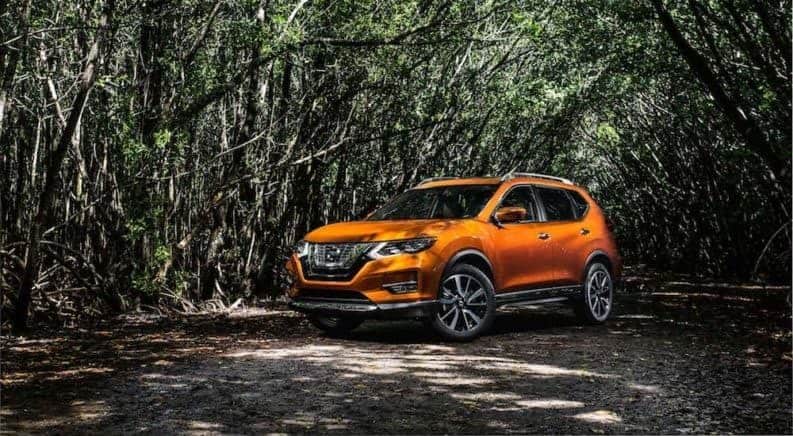After a while, comparison of Crossover / SUV offerings can feel like an exercise in redundancy. Often, there is little room for a manufacturer to distinguish themselves from their competition. After all, most SUV manufacturers are designing their offerings around the diverse demands of today’s families. In trying to satisfy everyone, they have their work cut out for them with respect to standing out from the crowd. That said, a comparison of the 2017 Nissan Rogue vs 2017 Hyundai Santa Fe Sport is a great example of how much disparity can exist within the class.
Price
Available in several different trim levels, the Nissan Rogue begins with the (base) S trim and an MSRP of $24,420. The next step up to the SV trim is a quick to increase to $25,640 and the Midnight Edition comes in at $26,630. Atop the line is the SL trim, which starts at $30,360 MSRP.
The Santa Fe Sport is served up with several different trim options. The base level is accessible at $25,350 MSRP. From here there is a leap, with the 2.0 starting at $31,700. The top-of-the-line 2.0 Limited Ultimate maintains this gap coming in at $36,500 to start, but there is the option of Front or All-wheel Drive for all of the trim options.
Overall, the Nissan Rogue is more competitive at each trim level. For this reason, it receives the first point of this comparison.
(1:0 Nissan)
Performance
The Nissan Rogue drives off the lot with a 2.5-liter 4-cylinder engine yielding, 170 horsepower and 175 lbs-ft of torque. At higher trims the Rogue has the option of upgrading to a 2.5-liter 4- cylinder. Regardless of trim level, you can expect 33 mpg (highway, 26 city) and in terms of general performance, the Rogue handles confidently.
The Santa Fe Sport is powered by a 2.4-liter 4-cylinder engine that delivers 185 horsepower and 172 lbs-ft of torque. Outside of the base trim, there is the optional upgrade to a turbocharged 2.0-liter 4-cylinder, which jacks the output to 240 horses and 260 lbs-ft of torque. Regardless of the powertrain option chosen, you can expect to average 22-23 mpg overall (26-28 highway, 19-21 city). While commendably-powered, these are below-average fuel economies, at best.
That said, the Santa Fe rates as average in terms of acceleration. In fact, “average” is an appropriate word to use across the board. Whether in terms of handling, braking or overall drivability there is little about the Santa Fe Sport that is actually “sporty,” or that stands out among its class.
Since both the Rogue and Santa Fe Sport earn confident, average handling scores, we were prepared to call this a draw, but the Rogue does offer notably better fuel economy.
(2:0 Nissan)
Exterior Design
In recent model years, the front-end design of Nissan vehicles has been successful in creating something unique and distinctive. And from that “first-impression” the brand made some truly smart choices in overall body design that don’t diminish it. This simplicity of design is intelligent with respect to reinforcing brand identity. Whether this is a positive or negative is subjective, but I happen to like the front-end design quite a bit.
Regarding its design, the Santa Fe Sport boasts clean contours and a clear intent. That said, it does little to shine and comes across as a very “by-the-numbers” approach to crossover styling.
In terms of exterior design, we are now running the risk of a sweep with the Rogue taking yet another point. (3:0 Nissan)
Interior Design
The Rogue makes nice use of materials in the design of its interior. This is fairly consistent across Nissan’s recent offerings, and higher-trim levels display a higher-end look than might be expected within this segment. As a whole, the layout creates a welcoming, roomy environment with little to criticize.
Overall, the interior design of the Santa Fe Sport is similar to the exterior, as it’s somewhat pedestrian. This is not necessarily a criticism, given that everything is designed in a very functional manner but it does little to convey a sense of exclusivity one might expect, especially at the higher trim levels.
(4:0 Nissan)
Infotainment
Bluetooth-enabled at the base level, the Rogue comes equipped with a four-speaker CD stereo with satellite radio and USB inputs. These are all fairly standard features within the class, but step up and the package explodes into excellence. With the SV trim, the sound system is upgraded to a six-speaker, while the SL comes with a nine-speaker BOSE system. Factor in the 7-inch touchscreen with surround-view cameras, built-in Navigation, “Eyes-Free” Siri iPhone control and Nissan Connect (emergency services), and the Rogue sits confidently in the lead.
At the base level, the Santa Fe Sport comes Bluetooth-enabled with a six-speaker sound system with CD player, satellite radio, and USB / audio input jacks, which ticks all of the primary boxes of today’s expectations. Factor in a 5” display screen with rearview camera, and we have no real criticisms. Unfortunately, you don’t get the same kind of added perks at higher-trim levels.
That said, the Rogue manages to shut down the Santa Fe Sport with very little opposition (5:0 Nissan)
Final Results
With very little competition from Hyundai’s Santa Fe Sport, the Nissan Rogue stands head and shoulders above as the victor of this comparison. While we always encourage people to research for themselves, this might just be the best example of disparity that we’ve seen within the Crossover / SUV class.




